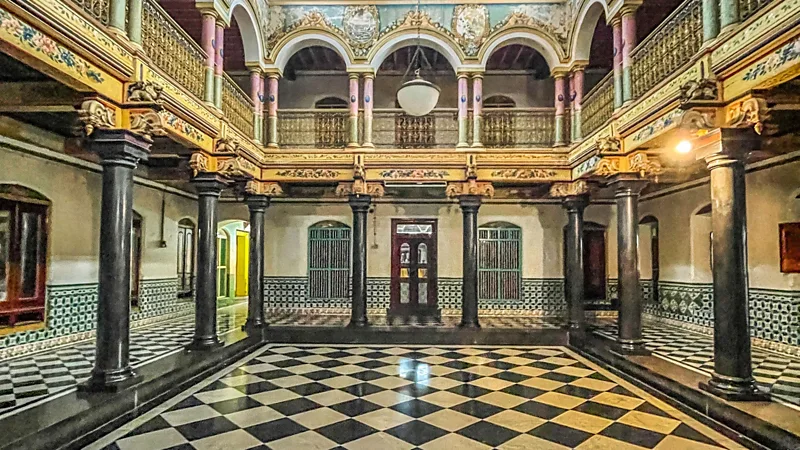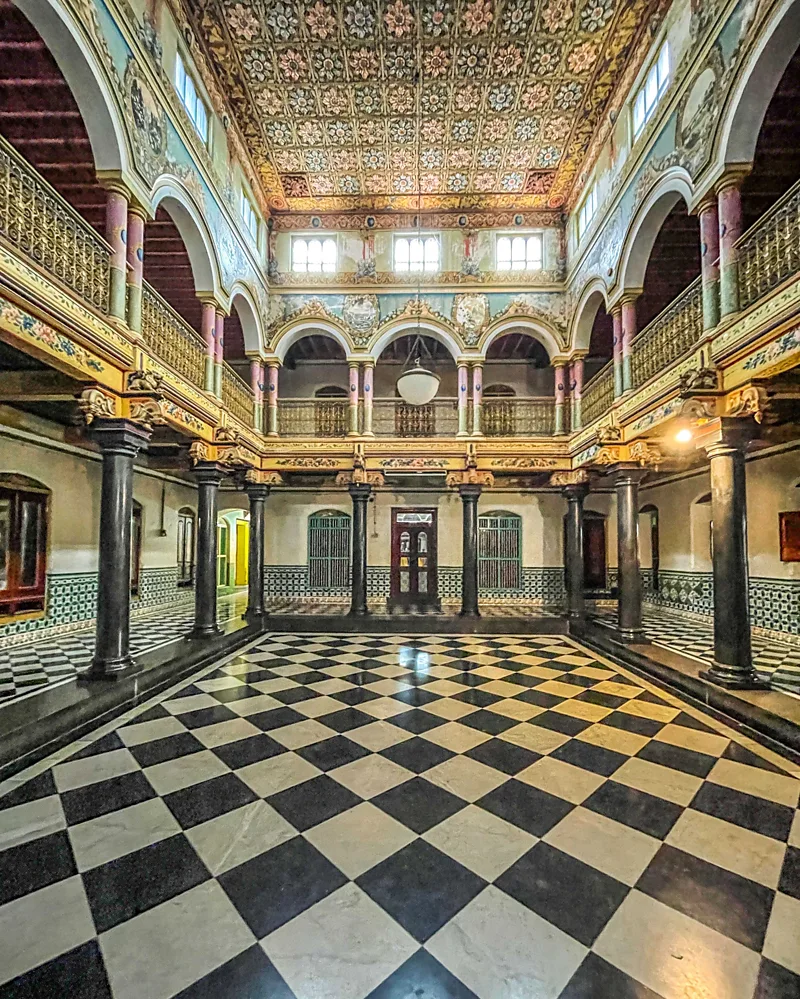India's 10,000 forgotten mansions
 The Chettinad mansions, once symbols of the prosperity and affluence of the Nattukottai Chettiar community, now stand in ruins across Tamil Nadu's Chettinad region. Upon arriving in Karaikudi, a town within this area, I observed the grandeur of these structures as my taxi navigated through the rain-soaked streets and surrounding villages. The sight of hundreds of crumbling villas lining the lanes, silhouetted against the twilight sky, evoked a sense of beauty tinged with emptiness.
The Chettinad mansions, once symbols of the prosperity and affluence of the Nattukottai Chettiar community, now stand in ruins across Tamil Nadu's Chettinad region. Upon arriving in Karaikudi, a town within this area, I observed the grandeur of these structures as my taxi navigated through the rain-soaked streets and surrounding villages. The sight of hundreds of crumbling villas lining the lanes, silhouetted against the twilight sky, evoked a sense of beauty tinged with emptiness.
The Chettinad region boasts over 10,000 opulent mansions, many of which are expansive, covering vast areas. These magnificent homes were constructed by wealthy merchant families belonging to the Nattukottai Chettiar community, who amassed significant fortunes through the trade of precious stones in Southeast Asia. Their economic zenith occurred during the late 19th and early 20th centuries, coinciding with the construction period of most of these mansions.
With the onset of World War Two in 1939, the overseas trading activities of the Chettiars suffered a significant blow, leading to a rapid decline in their wealth. This period marked a dark chapter in their history, compelling many Chettiars to seek employment opportunities outside of Chettinad. Consequently, a substantial number migrated out of India, abandoning their ancestral homes.
Today, Chettinad is renowned for its spicy chicken Chettinad dish and the prized antiques found in Karaikudi. However, many travelers remain unaware of the opulent mansions scattered across the 73 villages that constitute the region. While most of these mansions lay in a state of disrepair, a few passionate owners have converted them into heritage hotels and museums, endeavoring to preserve the rich legacy of the Chettiars.
The Magnificence of Chettinad Mansions"
Upon reaching the village of Kanadukathan, located 15km from Karaikudi, I checked into the Chettinadu Mansion, a century-old mansion that had been transformed into a hotel where I would be staying for the next two days. Welcoming me with a warm smile was A. Chandramouli, the elderly proprietor, who expressed his delight in revitalizing the mansion as his retirement project.
Sharing the history of the mansion, Chandramouli mentioned that it was constructed by his grandfather between 1902 and 1912. Spanning four generations, including his own family, the mansion held a significant place in their heritage, motivating him to undertake its preservation. As I explored the vast rooms and numerous courtyards spread across the 43,000 square feet property, I was mesmerized by the extravagant details at every turn.
The mansion boasted an imposing white facade adorned with exquisite stained-glass windows, while its grand entrance hall showcased a lavishly decorated gold ceiling, sparkling crystal chandeliers, and antique furniture. Notably, the courtyard, surrounded by majestic pillars painted in a striking cerulean blue, captivated my attention. Ascending a narrow wooden staircase, I discovered a breezy corridor leading to elegantly appointed guestrooms, each featuring white iron lace balconies overlooking the surroundings.
Architectural Fusion: The Intricate Beauty of Chettinad Mansions"
 Chandramouli remarked on the origins of the mansion's materials, citing Burma for timber, Belgium for mirrors and chandeliers, and Italy for marble flooring. He pointed out the Spanish black granite columns and the English blue cast-iron pillars.
Chandramouli remarked on the origins of the mansion's materials, citing Burma for timber, Belgium for mirrors and chandeliers, and Italy for marble flooring. He pointed out the Spanish black granite columns and the English blue cast-iron pillars.
As I explored further, I marveled at the intricate furnishings, including my own room with its private terrace and walls adorned in the trompe l'oeil technique. Building these mansions was a significant endeavor for the Chettiars, who invested both their finances and emotions into realizing their architectural dreams. Influenced by European styles, they collaborated with local architects and sourced materials globally, resulting in features like Gothic facades, marble floors, stained glass windows, and Eastern tiles. Yet, they also retained elements of traditional Tamil architecture such as spacious courtyards, elevated verandas, intricately carved wooden frames, and stucco reliefs depicting Hindu motifs.
Dr. Seetha Rajivkumar, a leading authority in architecture at Adhiyamaan College of Engineering in Tamil Nadu, highlighted the unique blend of outside inspirations and local culture evident in Chettinad's architecture. This fusion, she explained, is what makes these structures truly remarkable, offering visitors a window into the evolution of architectural styles while preserving the essence of their cultural heritage.
The typical mansion in the region boasts over 50 rooms and several courtyards, often sprawling across more than an acre, earning them the local moniker of "periya veedu" or "big houses." Chandramouli elucidated that these grand structures were initially built by ancestors to accommodate joint families, providing a sense of security for women and children while the men were away on business. In their prime, these mansions housed upwards of 70 to 80 family members simultaneously.
Embarking on a two-day journey, I devised a route to explore the mansion-rich areas of Kanadukathan, Athangudi, and Karaikudi. Engaging a tuk-tuk driver, I visited around a dozen villas, each bearing its own narrative and condition.
My inaugural stop led me to the opulent Athangudi Palace, tucked away in the lesser-known village of Athangudi. This erstwhile mansion, now transformed into a museum, left me spellbound from the moment I set foot inside its majestic reception hall. The grandeur unfolded before me: a vast marble floor from Italy, columns crafted from Spanish granite adorned with intricately sculpted lion heads, windows boasting Belgian stained glass, a balcony of wrought iron supporting delicately frescoed Mughal arches, and a ceiling adorned with ornate floral tiles imported from Japan. Truly, the mansion exuded an aura fit for royalty. My next destination was the Bangala, Chettinad's inaugural heritage hotel nestled in the heart of Karaikudi. Initially, I intended to participate in an exclusive Chettinad cooking class, but I found myself captivated by the mansion's intriguing backstory.
My next destination was the Bangala, Chettinad's inaugural heritage hotel nestled in the heart of Karaikudi. Initially, I intended to participate in an exclusive Chettinad cooking class, but I found myself captivated by the mansion's intriguing backstory.
Unlike the typical family homes, Bangala had a distinct purpose; it served as a venue for gatherings and celebrations owned by the affluent MSMM Chocalingam Chettiar family, known as the MSMM family. Primarily, it catered to entertaining the male members of the family, with women excluded from its premises.
Ironically, the management of Bangala has now transitioned to the dynamic Meenakshi Meyyappan, the granddaughter-in-law of the MSMM family. At 89 years old, Meyyappan energetically oversees all aspects of the hotel's operations and personally curates its menus. A talented chef herself, Meyyappan co-authored "The Bangala Table: Flavors and Recipes from Chettinad," a culinary masterpiece that not only showcases the local cuisine but also delves into the rich cultural and historical tapestry of the region.
During my tour, I received invitations from gracious homeowners who still resided in their private residences. However, some, such as the magnificent Chettinad Palace in Kanadukathan, were visibly closed off with chains from the exterior. Numerous others remained abandoned, caught in ongoing legal disputes over ownership and faced with prohibitive expenses for restoration. Rajivkumar emphasized the substantial financial investment required for renovating Chettinad's homes, which often amounts to thousands of dollars. Furthermore, these expenses are recurrent, as the buildings demand consistent maintenance and repairs. Compounding the challenge is the lack of engagement from multiple property owners, making conservation efforts a daunting endeavor.
Rajivkumar emphasized the substantial financial investment required for renovating Chettinad's homes, which often amounts to thousands of dollars. Furthermore, these expenses are recurrent, as the buildings demand consistent maintenance and repairs. Compounding the challenge is the lack of engagement from multiple property owners, making conservation efforts a daunting endeavor.
Despite these hurdles, both Meyyappan and Chandramouli remain hopeful. Chandramouli highlighted that only a fraction of Chettinad's mansions have undergone tourist-focused renovations, while a significant portion has fallen into complete disrepair. He stressed the importance of collective community action to revive the remaining structures.
Meyyappan, who initiated the annual Chettinad Heritage and Cultural Festival, aims to reinvigorate interest in Chettinad's heritage and culture as a means to rejuvenate the dilapidated mansions. She emphasized the critical role of awareness in conservation efforts, with the festival serving as the inaugural step towards achieving this goal.
Despite Chettinad's relatively low profile, its neglected mansions are experiencing a gradual resurgence, thanks to the dedication of local advocates. With a singular focus on preserving the Chettiar legacy and fueled by determination, individuals like Meyyappan and Chandramouli remain steadfast in their commitment.








































